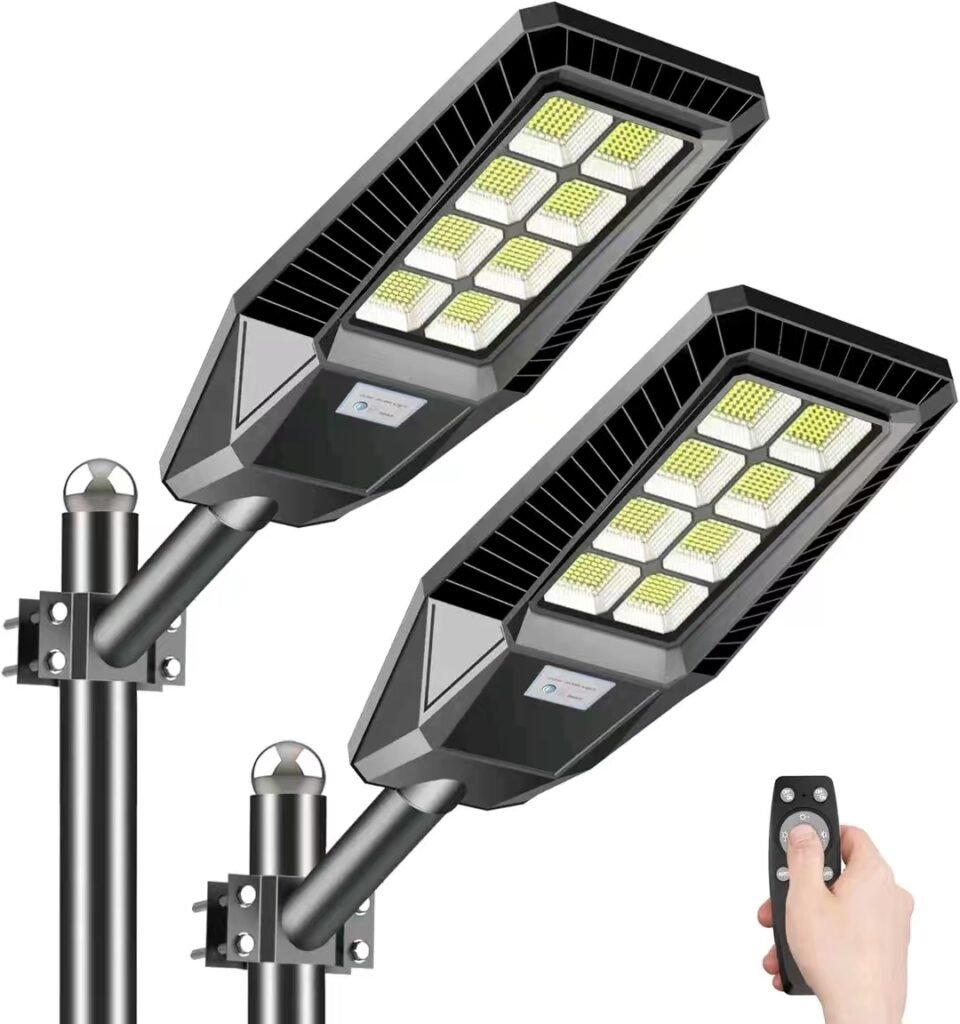Street lights play an important role in urban lighting and can facilitate people to travel better. Today, LED solar lights are very common. The use of solar photovoltaic cells to provide electricity, and LED solar energy as a new type of green energy, coupled with the war between Russia and Ukraine, further exacerbated the problem of energy shortage. Oil is a non-renewable resource that will run out sooner or later. Therefore, making full use of solar energy resources has positive significance for alleviating the problem of conventional energy shortage.
What is the LED solar light system?
LED solar streetlights are composed of the following parts: solar panels, solar controllers, battery packs, LED street lamps, and light poles, and some are also equipped with inverters.
1. Solar panels
The solar panel is the core part of the solar street light system, which converts solar energy into electrical energy and stores it in the battery through the controller. Solar panels generally use monocrystalline silicon or polycrystalline silicon as the material.
2. Solar controller
The controller is an important accessory in the street light system, which connects the panels, batteries, and lamps through the controller. The controller plays a control and protection function that controls the output power of the load, charge, and discharge, battery overshoot and over-discharge protection, and other control and protection functions that are related to the normal operation of the system.

3. Battery
The battery is a high-value accessory in the solar system, which plays the role of storing electricity during the day and supplying power to the street light through the controller at night.
4. LED street light fixtures
Generally, LED lamps are used, and the selection of suitable lamps can ensure good lighting effects. The LED lamps produced by Shandong Kaichuang Optoelectronics use Osram, Philips, and other brand light sources, which are stable and have a light efficiency of more than 160Lm/w, which plays a significant role in solar street lighting systems.
5. Light pole
According to the road width and spacing, choose the appropriate height of the lamp pole to ensure that the lighting effect of the LED street lamp can be better played on the premise of energy saving.
6. Solar inverters
A. What is a solar inverter
An inverter, also known as a power regulator and power regulator, is an indispensable part of a photovoltaic system. The main function of the photovoltaic inverter is to convert the direct current generated by the solar panel into the alternating current used by home appliances.
Through the full-bridge circuit, the SPWM processor is generally used to modulate, filter, boost, etc., to obtain a sinusoidal AC power that matches the lighting load frequency, rated voltage, etc. for the end user of the system. With an inverter, a DC battery can be used to supply AC power to the appliance.
The efficiency of solar inverters refers to the growing market for solar inverters (photovoltaic inverters) due to the demand for renewable energy. And these inverters require extreme efficiency and reliability.
The primary function of this type of inverter is to convert the incoming DC voltage to a stable value. This function is implemented by a boost converter and requires a boost switch and a boost diode.
B.The structure of the solar inverter
In the first configuration, the boost stage is followed by an isolated full-bridge converter. The role of the full bridge transformer is to provide isolation. A second full-bridge converter on the output is used to convert the DC to alternating current (AC) voltage from the first-stage full-bridge converter. Its output is filtered before being connected to the AC grid via an additional two-contact relay switch to provide safe isolation in the event of a fault and isolation from the supply grid at night.
The second structure is the non-isolated scheme. Among them, the AC alternating voltage is directly generated by the DC voltage output by the boost stage.
The third structure utilizes an innovative topology of power switches and power diodes to combine the functions of the boost and AC generation sections in a dedicated topology to make the inverter as efficient as possible despite the very low conversion efficiency of solar panels Close to 100% is very important. In Germany, 3kW series modules installed on south-facing roofs are expected to generate 2,550 kWh per year. If the inverter efficiency is increased from 95% to 96%, an additional 25kWh can be generated per year.
The cost of generating this 25kWh with additional solar modules is comparable to adding an inverter. Since increasing efficiency from 95% to 96% does not double the cost of the inverter, investing in a more efficient inverter is a must. For emerging designs, increasing inverter efficiency most cost-effectively is a key design criterion.
The reliability and cost of the inverter are two other design criteria. Higher efficiency can reduce temperature fluctuations over the load cycle and thus improve reliability, so these guidelines are related. The use of modules also increases reliability.
C. LED Solar Inverter Features
The inverter not only has the function of DC-AC conversion but also has the function of maximizing the performance of the solar cell and the function of system failure protection.
In summary, there is an automatic operation and shutdown function, maximum power tracking control function, anti-independent operation function (for the grid-connected system), automatic voltage adjustment function (for the grid-connected system), DC detection function (for the grid-connected system), DC grounding detection Function (for the grid-connected system). Here is a brief introduction to the automatic operation and shutdown functions and the maximum power tracking control function.
1. Automatic operation and shutdown function: After sunrise in the morning, the solar radiation intensity gradually increases, and the output of the solar cell also increases. When the output power required by the inverter task is reached, the inverter starts to operate automatically.
After entering the operation, the inverter will take care of the output of the solar cell module all the time. As long as the output power of the solar cell module is greater than the output power required by the inverter task, the inverter will continue to operate; The inverter can also run on rainy days. When the output of the solar cell module becomes smaller and the output of the inverter is close to 0, the inverter forms a standby state.
2. Maximum power tracking control function: The output of the solar cell module changes with the solar radiation intensity and the temperature of the solar cell module itself (chip temperature). In addition, because the solar cell module has the characteristic that the voltage decreases with the increase of the current, there is an optimal task point where the maximum power can be obtained.
The intensity of solar radiation is changing, as is the apparent optimal mission point. Regarding these changes, the task point of the solar cell module is always at the maximum power point, and the system has always obtained the maximum power output from the solar cell module. This control is the maximum power tracking control. The biggest feature of inverters for solar power systems is that they include the function of maximum power point tracking (MPPT).
Advantages of the LED solar light system
1. Durable, with a service life of more than two years. It is also very power-saving, can be used under low voltage, and is relatively safe to use.
2. Solar energy is a green and renewable resource that has a positive effect on alleviating the shortage of other conventional energy sources.
3. Compared with other street lights, the installation of LED solar lights is simple and convenient, and it is self-contained. There is no need to do a lot of basic engineering such as laying cables, digging trenches, and burying lines like ordinary street lights. It only needs a base to fix, all lines and control parts All can be installed in the light stand to form a whole, which can be used directly.
4. Although there are many parts and components of LED solar lights, the quality requirements are generally higher, and the price is naturally higher, which can save power and energy, which is also a very important advantage in the long run.
5. The operation and maintenance cost of LED solar streetlights is low. The solar power supply used by solar street lights has almost zero operating costs, except for a small part of the electricity cost generated by the pilot power supply wire transfer on rainy days. The entire system is automatically controlled without human intervention, and almost no maintenance costs are incurred.

Working principle
During the daytime, under the condition of light, the solar cell components generate a certain electromotive force, and the solar cell square array is formed by the series and parallel connection of the components so that the square array voltage can meet the requirements of the system input voltage. The battery is charged through the charge and discharge controller, and the electrical energy converted from light energy is stored.
At night, the battery pack provides input power for the inverter, and through the action of the inverter, the DC power is converted into AC power, and then sent to the power distribution cabinet, where the power is supplied by the switching function of the power distribution cabinet.
The discharge of the battery pack is controlled by the controller to ensure the normal use of the battery. The photovoltaic power station system should also have a limited load protection box and a lightning protection device to protect the system equipment from overload operation and avoid lightning strikes and maintain the safe use of the system equipment.
Principle of solar lamp system: The working principle of the system is simple. The solar cell made of photovoltaic principle receives solar radiation during the day and converts it into electrical energy for output. After the charging and discharging point, the controller is often in the battery. At night, when the illuminance gradually decreases The open-circuit voltage of the solar panel is about 101ux, and the open-circuit voltage of the solar panel is about 4.5v. The charge-discharge controller will act after detecting this voltage value, and the battery will discharge the battery.
After the battery is discharged, the charge controller acts, and the battery discharge ends. The main function of the charge and discharge controller is to protect the battery and prolong it’s service life of the battery.
The development prospect of solar LED lights
To save limited energy, solar LED lights are widely used in the market. As a form of new energy, it has the advantages of environmental protection and renewable energy, and more and more cities begin to use it. As an outdoor lighting product, it shows numerous advantages, can solve many environmental problems for society, and bring more economic benefits.
Thanks to its unique secondary optical design, it directs its light to the desired range, further improving efficiency and energy savings.
With its gradual development and greatly improved role in urban streets, LED solar lights must not only meet basic needs, but also improve the style and taste of the city, move forward in the direction of works of art, and add luster to the city. Let’s keep up with the times…




